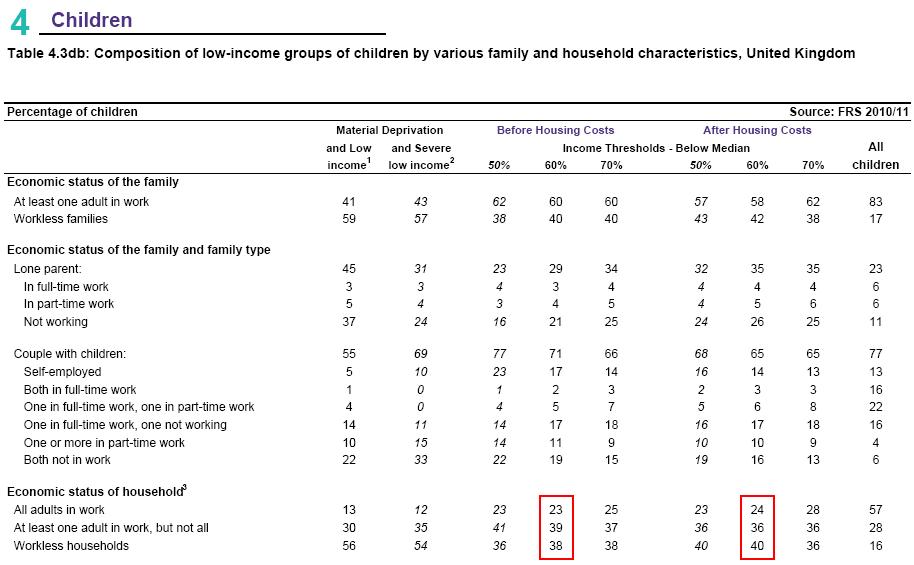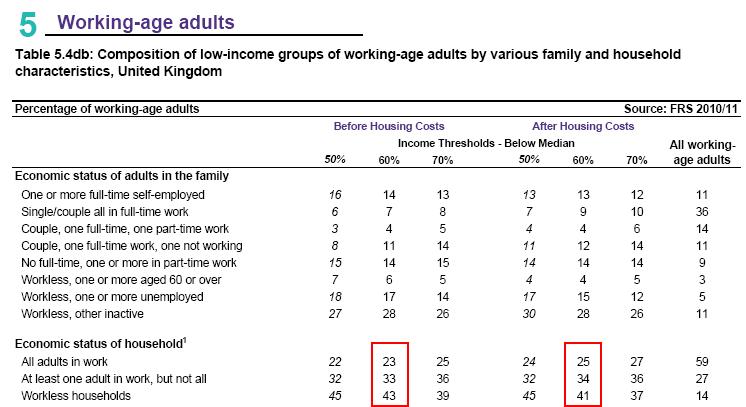Are the majority of poor children in working households?
"At a time of mass unemployment, Iain Duncan Smith is hectoring parents to get a job as a solution to child poverty, even though more working families are classed as poor than those with no one in work."
Owen Jones in the Independent, 15 June 2012
"[Iain Duncan Smith] refuses to answer two questions: what about all those who are poor because they can't find jobs? What about the 62% of the poor in work, good parents, committing no sin, but who still can't earn enough to stay out of poverty?"
Polly Toynbee in the Guardian, 15 June 2012
Last week saw refreshed debate over child poverty in the UK, following the release of new figures suggesting that 300,000 fewer children are living in poverty compared to last year.
Several left-leaning commentators hit out at the Work and Pensions Secretary, Iain Duncan Smith, after he proposed to change the way in which poverty is measured in a bid to better detect children in need.
One often-cited figure by the columnists has been - perhaps contrary to popular wisdom - that the majority of children in poverty actually live in working households. The same has been claimed separately by the Guardian and the Joseph Rowntree Foundation.
So where is the evidence for this?
Analysis
Official figures from the Department for Work and Pensions (DWP) on households below average income (HBAI) were released yesterday. The statistics are gathered from the Family Resources Survey (FRS).
The release provides data on children in poverty, and also has sections on working-age adults, pensioners, and the population as a whole. We can assume for now that most of the recent claims being made refer to child poverty specifically.
Child poverty
Page 112 of the document gives us the necessary figures showing the composition of low-income groups of children by various characteristics. However as the table below demonstrates, reading these statisitcs is not as simple as it may sound:

The 62 per cent figure quoted by Polly Toynbee is found by examining the category 'Economic status of household' (where pensioners out of work are excluded, but those in work are included). Using the official poverty definition of below a median of 60 per cent of household income (before housing costs are taken into account), 38 per cent of children in poverty are in workless households - or 62 per cent where at least one adult is in work.
However this isn't to be confused with the 'economic status of the family' which is also included and shows 40 per cent of children in poverty are in a workless family. So what's the difference?
The HBAI refer to families as 'benefit units' which they define as:
"A single adult or a couple living as married and any dependent children; from January 2006 same-sex partners (civil partners and cohabitees) are also included in the same benefit unit."
Meanwhile, a 'household' is:
"A single person or group of people living at the same address as their only or main residence, who either share one meal a day together or share the living accommodation (i.e. living room). A household will consist of one or more benefit units."
Since households can contain several families, it is therefore possible that, while a child could be living in a workless family, they might not be living in a workless household.
Nevertheless, this isn't the only low income indicator available for children. There is also a measure of 'material deprivation' which, according to the DWP, is defined as:
"Those who have a material deprivation score of 25 or more and household income below 70 per cent of contemporary median income, Before Housing Costs. This broadens the measures of child poverty by capturing those children that are going without items considered necessary to enjoy a decent standard of living."
It's of course debatable whether this gives a superior proxy by which to measure the living standards of families in poverty, but a look at the same statistics for this indicator does give a different result - a majority of materially-deprived children live in workless households and workless families (all measured before housing costs are accounted for).
Working-age poverty
While both Polly Toynbee and Owen Jones begin by talking about child poverty, it is worth bearing in mind that the case for adults of working age is less clear cut.
Page 170 of the statistics provides the same data for working-age adults as for children earlier in the document:

Again, a minority of working-age adults in poverty is in a workless household - 43 per cent before housing costs are taken into account. However, looking at the economic status of adults in the family, 51 per cent in poverty are in a workless family before housing costs, dropping to a minority after housing costs are factored in.
Similarly, page 66 of the statistics shows that, across the whole population, 57 per cent of individuals in poverty are in a workless family, falling to 51 per cent after housing costs are accounted for.
Finally, among pensioners in poverty, 93 per cent are in a family where no one is working.
Conclusion
While we can't fault the columnists' statements, it is worth bearing in mind that there are a large number of different ways that statistics on child poverty and poverty more generally can be read.
While it does not drastically affect the statistics regarding child poverty, it is important to recognise the difference between households and families when making claims, as an individual can be in a workless family but will not necessarily show up as being in a workless household if other 'families' are resident and classed as "working".
So readers remain well advised not to take claims about poverty and worklessness at face-value. As is clear, the claimant could actually be referring to any number of possible measures.
CORRECTION
Full Fact originally published this article on Friday in which we made a series of errors in reporting the statistics, for which we apologise to our readers. The original version is still available via the 'revisions' tab.
Thanks to Declan Gaffney via Twitter and email we were able to resolve some of the confusion caused to both of us by the statistics and have hopefully arrived at the best available version of the facts.
We've also changed some references to 'working' to 'workless' where this wasn't clear.
If you read the figures differently, let us know on our Facebook page or email corrections@fullfact.org.